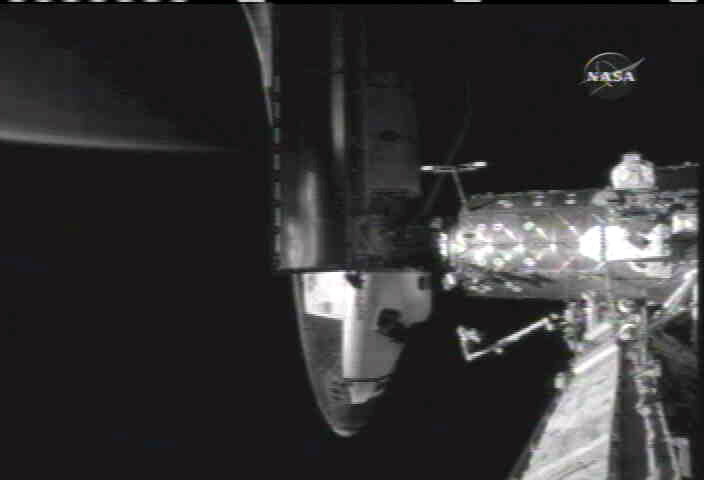Hard Hat Area: Shuttle Atlantis Docks at ISS Construction Site

This story was updated at 10:41 am EDT.
HOUSTON - An orbital construction crew ofsix astronauts arrived at the International SpaceStation (ISS) early Monday as NASA's Atlantis shuttle docked at thehigh-flying laboratory to deliver its first major addition since 2002.
Shuttlecommander Brent Jett deftly berthed Atlantis to a docking port on the station'sU.S.-built Destiny module at 6:48 a.m. EDT (1048 GMT) as both spacecraft circled the Earth at about 17,500 milesper hour.
"We've got a good view of you aswell, you're looking good," ISS Expedition13 flight engineer JeffreyWilliams told Jett as the shuttle neared the ISS. "Seeyou soon."
Atlantis docked at the space stationas the two spacecraft flew 218 statute miles above the southern Pacific Ocean, ending a two-day chase that beganwith the shuttle's successfulSaturday launch.
In addition to Jett, Atlantis'STS-115 astronaut crew includes pilot ChrisFerguson and mission specialists JosephTanner, DanielBurbank, HeidemarieStefanyshyn-Piperand StevenMacLean, a Canadian Space Agency shuttle flyer. The shuttle's cargo bayalso carries a $372million set of new solar arrays and two massive trusses, which the STS-115astronauts will attach to the space station's port side this week.
"Atlantis is headed your way with anew piece of space station in its trunk," flight controllers told Williams asthe shuttle approached the ISS.
Breaking space news, the latest updates on rocket launches, skywatching events and more!
Williams and his ISS crewmates,Expedition 13 commander PavelVinogradovand flight engineer ThomasReiter, have been anxiously awaiting Atlantis' arrival, which marks thesecond shuttle visit to the space station since July's STS-121mission with Discovery.
By 8:30 a.m. EDT (1230 GMT), all nine astronauts were trading smiles and handshakesinside the space station's Destiny laboratory.
Atlantis' STS-115mission marks NASA's third shuttle flight since the 2003 Columbia accident. Themission is also the first ISS construction flight since NASA's STS-113mission in November2002.
Today's docking also markedAtlantis' first return to the ISS since its STS-112mission in October2002, NASA said.
Resuming ISS Construction
One of the first major chores of thepost-docking day for the STS-115 crew is the removal of the 35,000-pound Port3/Port 4 (P3/P4) truss segments tucked inside Atlantis' cargo bay.
Burbank will use Atlantis' Canadian-builtrobotic arm to haul the 17.5-ton segments - which also feature two 120-footsolar arrays carefully folded and packed away - free of the shuttle so MacLeanand Williams can grapple the hardware with the space station's own roboticappendage.
"The idea was to get the truss outand get a head start," said Kirk Shireman, NASA's ISS MissionManagement Team chairman for Atlantis' flight, during a Sunday briefing.
Shireman said that shuttle-ISS dockings aretypically followed by relatively light duties. But by pre-positioning the P3/P4truss today, the STS-115 crew will save time for their mission's firstspacewalk on Tuesday, he added.
MacLeanwill be the first from his country to wield the station's Canadian-built roboticarm, known as Canadarm2, when he accepts the P3/P4 truss from Atlantis'outstretched grapple in what he's called "the Great Canadian Handshake."
That robotic "handshake" isscheduled to occur at 10:45 a.m. EDT (1445 GMT) and be shown live on NASA TV.
Mission control roused the STS-115 crewwith a solo cello performance specially chosen for Burbank and performed by his children.
Busy Docked Mission
Atlantis' ISS arrival kicks offeight, fast-paced days of joint operations for the STS-115 and ISS astronauts.
By Friday, the two crews expect tohave staged threespacewalks from the station's Quest airlock to equip the P3/P4 truss withvital power and cooling lines, remove launch restraints and deploy the newsolar arrays.
The first of those extravehicularactivities (EVAs) will be performed by Tanner - a veteranof ISS solar panel work - and Stefanyshyn-Piper, who is makingthe first spaceflight and spacewalks of herastronaut career during the STS-115 mission.
Instead of sleeping in Atlantistonight, Tanner and Stefanyshyn-Piper will spend thenight in the station's Quest airlock, which will be shut at about 1:57 p.m. EDT (1757 GMT) today.
Nicknamed the EVA "campout,"the move allows spacewalkers to purge nitrogen from their bodies while theysleep at a slightly lower atmospheric pressure - 10.2 psi - ratherthan the standard 14.7 psi aboard Atlantis or the ISS.
Shireman said the campout will save Tannerand Stefanyshyn-Pipertime preparing for tomorrow's packed spacewalk, but sadly includes none of thetraditional Earthly camping treats.
"Despite popular belief there are nosmoresor fires involved," Shireman said.
- VIDEO: First Tasks of NASA's STS-115 Mission
- Gallery: Prepping Atlantis
- Complete Space Shuttle Mission Coverage
- NASA's STS-115: Shuttle Atlantis to Jump Start ISS Construction
- The Great Space Quiz: Space Shuttle Countdown
- Complete Coverage: ISS Expedition 13

Tariq is the award-winning Editor-in-Chief of Space.com and joined the team in 2001. He covers human spaceflight, as well as skywatching and entertainment. He became Space.com's Editor-in-Chief in 2019. Before joining Space.com, Tariq was a staff reporter for The Los Angeles Times covering education and city beats in La Habra, Fullerton and Huntington Beach. He's a recipient of the 2022 Harry Kolcum Award for excellence in space reporting and the 2025 Space Pioneer Award from the National Space Society. He is an Eagle Scout and Space Camp alum with journalism degrees from the USC and NYU. You can find Tariq at Space.com and as the co-host to the This Week In Space podcast on the TWiT network. To see his latest project, you can follow Tariq on Twitter @tariqjmalik.
